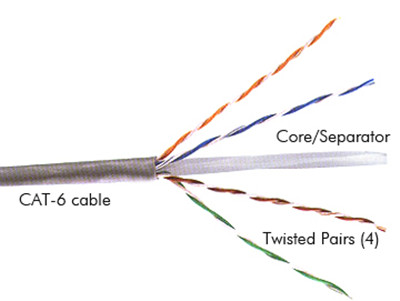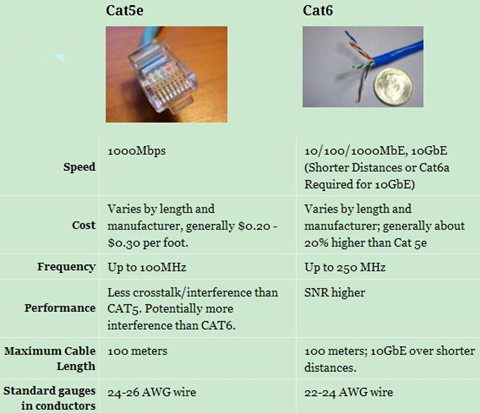Cat 6 cables have been around for over 14 years. When it came out in 2002, this cable gave the first glimpse of the 10 Gigabit networks as a possibility, although planing on cat 6 cabling costs 30% more than cat 5e. In the past few years, hardware costs have come down and allowed Gigabit networking to become easier to afford, especially for the 10GbE. Recently, many people are exhibiting renewed interest and asking themselves about cat 6 cabling. Hopefully, this brief guide will help you get to know the cat 6 cables from the aspects of bandwidth, cabling parameters and cabling performance.
What Is Cat 6?
Cat 6 cables came out only a few years after cat 5e. It is a great improvement over cat 5e with a connectivity of up to 10 gigabit Ethernet at 250 MHz. In addition to this, there are some significant differences of cat 6 cables. To begin with, cat 6 cables are specified to be interoperable between different vendor’s products and are fully backward with all lower categories. That is to say, cat 6 components from different vendors can be mixed and matched to from a minimally compliant category channel, and even can be substituted in any existing cat 5/5e cables.

Additionally, cat 6 cables have a tighter tolerance on impedance variations, although they have the same niminal impedance as cat 5/5e. Impedance variations are specified in terms of a parameter called Return Loss. A higher value of Return Loss (in dB) means better Impedance matching between components and lower signal reflections and re-reflections. As a result, category 6 provides better Bit Error Rate (BER) performance for Fast Ethernet (100BASE-TX) and Gigabit Ethernet (1000BASE-T) networks.
Thus, for those who want to future-proof their residential or commercial network as much as possible without a significant cost increase, cat 6 is a great choice. That doesn't mean it'll protect your network from cyborgs from the future or anything, it just means it will keep it up to date for longer when the next big thing comes along.
What Is the Difference Between Cat 5 and Cat 6 Cables?
The most obvious difference between cat 5 and cat 6 cables is the cable construction. The diameter of category 6 cables are in the range of 0.21 to 0.25 inch (5.3-5.8 mm) compared to category 5/5e, which is in the range of 0.19 to 0.22 inch (4.8-5.5 mm). As a result, the cat 6 cables provides a lower insertion loss over the specified frequency range. And a lower Insertion Loss means a stronger signal at the Receiver compared with category 5 / 5e. This improves the noise immunity to external and internal noise sources. Most of us would know that cables with a lower Insertion Loss can support longer distances or a higher temperature range for certain applications.

Another feature of category 6 cables has a tighter twist in the cable. It is nearly about a length of 0.5 inches or less to reduce crosstalk interference between pairs, while cat 5e does not allow this feature. cat 5e cable has a tendency to have a higher delay and skew than cat 6 cable. That means that even though both cat 5e and cat 6 can do 1 Gigabit networks, cat 5e may have a longer delay for the signal to get from one side to the other, which will give the appearance that it runs slower.
How About Installation?
The installation of category 6 cables is very much the same way as their category 5 / 5e counterparts. However there are some design and installation issues that the contractor and the installer must pay greater attention to, including the cable terminations and the cable pathway fill. The larger physical cable diameter needs to be taken into account when routing cables at cross-connects and in provisioning cable pathways. When terminating category 6 cables it is very important to ensure that the pair twists are maintained right up to the point of termination. It is particularly important to follow manufacturer’s instructions for terminating connectors.
What About the Performance of Your Network When Cat 6 is installed?
NEXT, FEXT, ILD Noise, Alien Crosstalk and Impulse noise are the noise sources that needed to be taken into account when evaluating your network performances. When compared with cat 5 / 5e cabling, the biggest benefit is the much-improved Signal-to-Noise Ratio (SNR) using the Bandwidth employed by today’s applications and also for future applications. That is because that category 6 provides about 12 dB (or 16 times) better Signal-to-Noise Ratio compared to category 5 / 5e over a wide frequency range.
Why Do We Need Cat 6?
Many people may reckon that category 5e is good enough for what is needed today and in the foreseeable future. So why do we need cat 6 cables? In fact, no one can predict the future. For today’s applications, there has been some work done by others that indicates category 6 provides higher Data Throughput (fewer bit errors) than category 5e for 100BASE-TX and 1000BASE-T applications. This work shows that some network switch ports are at the limits of the IEEE 802.3ab standard (i.e. marginally compliant) and are more susceptible to cabling and temperature variations. NORDX are presently in the process of generating some information on the Data Throughput of category 6 and category 5e in the presence of outside noise.
Why Not Skip Cat 6 and Go Directly to Optical Fiber?
It is known to all that cost is one of the biggest factors that impede the widely development of fiber optic network. Although today the cost differential between copper and fiber cabling is decreasing, when compared it with copper cables, combined with the even greater differences between the electrical versus optical networking devices, the factors deterrent to the use of fiber optic cable continues to be the cost of the active optical networking equipment. The comparatively high total cost of ownership for optical networking makes fiber optic cables very difficult to use in horizontal distribution except where environmental noise, or security, or ultra high performance requirements made copper solutions impractical or inoperable.
Besides the difference in prices and availability on the market, another reason that supports high performance copper cabling is the need for remote powering for VoIP telephones and other devices. This is an important development. IEEE is in the process of developing a DTE Powering standard that would enable end users to plug in a variety of devices into the data outlet connector in the wall. The networking equipment or the mid-span power source would detect and recognize the type of device, e.g. an IP phone, sensor, camera, etc. and deliver the appropriate power as required by the device. This is an important step towards a ubiquitous network that is designed for device independence. When powering remote devices, category 6 cabling has advantages over category 5e because of the lower DC resistance (23 AWG) and ‘Pair Balance’ recommendations, which is a new parameter for category 6 components.
To sum up, when it comes to copper vs fiber, we’d like to say that optical fiber is generally chosen for systems requiring higher bandwidth or spanning longer distances than copper can accommodate. However, copper cables might be the most cost-effective and reliable solutions for now.
Conclusion
From the above article, we know that with the combination of performance, longevity, and investment protection, as well as the new attributes of interoperability and backward compatibility, category 6 cabling is undoubtedly the smart choice for 10-Gbqs cabling system implementations. FS.COM offers a full range of copper components including the cat 5, cat 5e, cat6 cables, etc. Fiber optic cables like LC-SC fiber cable are provided as well.
评论
发表评论